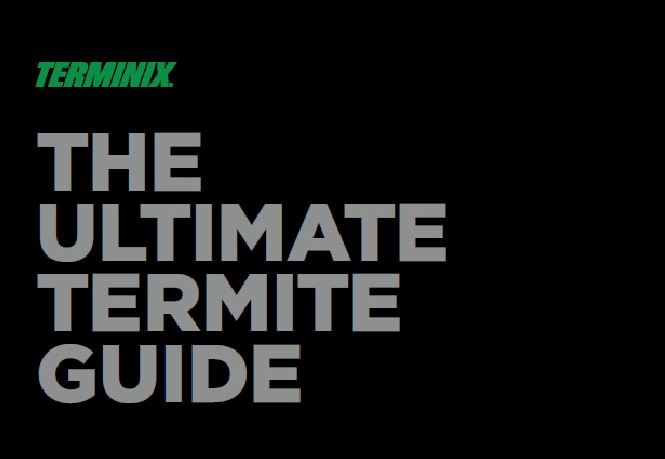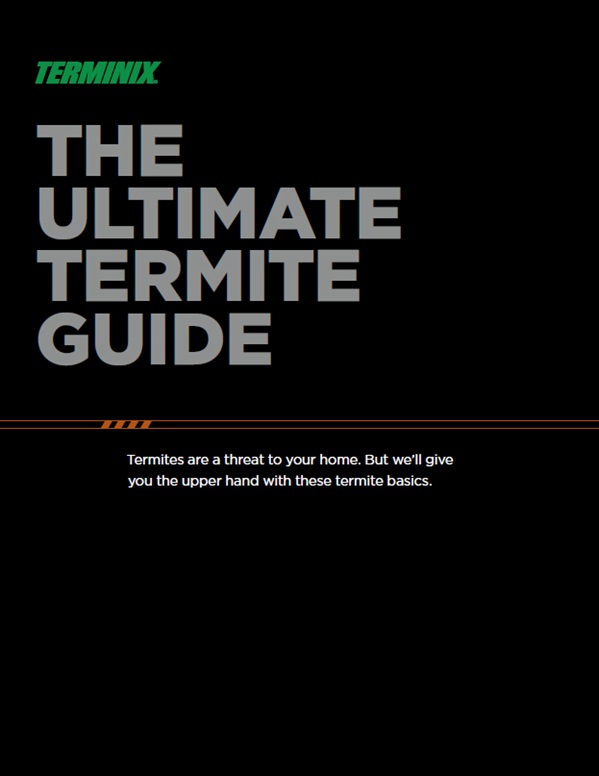Termites are a threat to your home. But we’ll give you the upper hand with these termite basics.

Termites are a threat to your home, causing billions of dollars in damage and treatment costs in the United States each year. With this guide, we give you the upper hand with some termite basics.
Click the image of termite guide below to download the PDF:
Read the text of the guide below:
Read the text of the guide below:
Species and Habitat
Termites are social insects that live in large colonies. They have a caste system (made up of workers, soldiers and swarmers) that revolves around a queen and her king. In the United States, they may be found everywhere except Alaska. There are roughly 41 species found in the U.S., and these insects primarily feed on wood and plant matter. Only about 10 percent of the more than 2,500 species of termites in the world are considered pests.
Most termites fall into three groups: subterranean (which includes the invasive Formosan species), drywood and dampwood.
Subterranean
These termites infest dead wood in nature and structural wood in homes, sheds or other buildings. Subterranean termite soldiers are smaller than drywood and dampwood soldiers. They do, however, live in larger colonies than many other termite types. The colony can be several feet below ground and typically stays in contact with the soil, despite a far-reaching structural infestation. Like Formosan termites, these species will create mud tubes to get themselves into a structure, and they eat primarily the soft wood — meaning their tunnels go along the grain. Subterranean termite species are found in every U.S. state except Alaska, though they are more common in the South.
Formosan Subterranean
Formosan termites, a species of subterranean termites, are always hungry — eating 24/7 — and can chew through a lot of wood, including live trees. Formosan termites have the largest colonies of any termite species in North America. Other subterranean species can have over a million termites in a colony, while Formosan colonies have up to 15 million. The workers in these colonies chew up wood, then spit it back up to feed the rest of the colony. Formosan termites have shelter, or mud tubes, that they use to maintain a steady temperature and hide themselves from predators. They start an infestation at the surface of the wood, where mud tunnels are visible, then burrow into it, eating the soft wood along the grain. This invasive species is primarily found in the Southeastern U.S.
Drywood
These termites infest dry wood. They eat voraciously across the grain, which can lead to structural collapse of the wood. They often infest homes, fences and trees, along with other wooden structures. They do not need to remain in contact with the soil or have access to water. Due to this and other biological differences, treatment methods for them are not the same as those used for other termite species. They are commonly found in a strip running from Florida to California, as they need warm to tropical climates with plenty of wood structures and mild winters.
Dampwood
The largest termites in North America are dampwood termites, even though they have smaller colonies than other species. These termites require regular contact with water and high humidity to survive. They are common in humid or coastal regions, where they infest decayed wood that is near wet soil or a water leak. Their galleries (or tunnels dug through the structure) are large and open, and the colony can survive completely within the wooden structure they are infesting — there’s no need for them to maintain contact with the ground. These termites are primarily found in Montana, Idaho, Nevada, Oregon, California, Washington and parts of Florida.
Common Termite Questions
You asked. We answered. The following questions look at how termites behave and what that may cost you.
How much does it cost to get rid of termites?
Termites in the U.S. cause an average of $5 billion in damage every year. According to Terminix® customer data, the average cost to treat and repair an active infestation is about $8,000.
Do termites have wings?
When a colony is 3–5 years old, it produces reproductive alates, also known as “winged” male and female termites or “swarmers.”
Are termites active year-around?
Termites are more active in warmer temperatures. However, once inside a warm home, they will remain active year-round. March through May is when many people see the winged termites that often help diagnose an infestation. However, swarms can happen at other times of year, depending on conditions and species.
What do termites look like?
Termites are small insects that can be white, brown or black, depending on the species and function within the colony. They are sometimes confused with ants.
Do termites fly around?
Only the alates (reproductive stage termites) fly. They leave the colony in swarms to start their own colonies elsewhere. Alates are sometimes confused with carpenter ants, which also have wings.
How do termites get into a home?
They seek out anything wooden. Untreated wood and improperly stored firewood can both offer termites a way to enter your home. They also enter through cracks in the foundation, bricks and mortar and other openings.
What does a termite eat?
Termites eat cellulose, which is found in wood and plants. They have incredibly strong jaws that allow them to chew through wood, digesting the cellulose and excreting the rest.
How do I know if I have termites in my home?
Alates emerging from walls or posts is a clear sign. Finding fecal pellets on horizontal surfaces is a sign of drywood termites. Hearing a hollow sound when you tap a wooden surface is another indicator.
Are termites attracted to light?
Yes. Alate swarms are attracted to light. They are often found near windows, light fixtures and doors.
Can I treat for termites myself?
It is not recommended. Termite infestations often reach into the structure of a home and require specialized treatments. Attempting this yourself is not advised, and even if you were successful, you would not be protected against future damage. If you discover termites, or suspect you have termites, you need to call a professional for a FREE Termite Inspection.
Signs of a Termite Infestation By Specifies
Not all termite damage looks the same. Here’s what you need to be on the lookout for when it comes to your home.
Subterranean Infestation Signs
Infestation markers may include mud tubes visible on walls, concrete or other surfaces and damaged wood where the grain is exposed. Damaged wood may also have a hollow sound when tapped with a hammer or screwdriver handle. Swarmers are another indication of a termite infestation.
Drywood Infestation Signs
Wood-colored fecal pellets (roughly the size of a coarse grain of sea salt) near openings and inside galleries, damage across the grain and smooth galleries are signs of this type of termite. Wood that appears blistered may be damaged by drywood termites, which often tunnel too close to the surface. Swarmers emerging from holes in the walls or the discarded wings of swarmers are other indicators of an infestation.
Formosan Infestation Signs
Mud tubes visible along surfaces leading to wood, damaged wood that appears wavy or “ribbed” due to these termites eating the soft wood and leaving the grain, and mud blocking small holes in walls may indicate a Formosan infestation. Swarmers are also an indication of a potential Formosan termite problem.
Dampwood Infestation Signs
Wood that sounds hollow when tapped, or wood that feels soft, may indicate a dampwood termite infestation. Damage near areas with high humidity and a lot of moisture also points to this type of infestation. Wood decay occurring near water leaks or areas where water collects should be checked for this type of termite.
5 Signs That Termites May Be in Your Home
- Shed wings
- Mud tunnels
- Rippled appearance in wood
- Blisters on wood surfaces
- Hollow sounds when wood is tappped
There are many other signs of an infestation. If you suspect termite activity, contact us for a FREE Termite Inspection.
Prevention Tips
- Store all firewood away from the home on raised, non-wood platforms.
- Make sure 4 inches of the foundation is showing and that no mulch touches the home. Siding should not extend down to the soil.
- Make sure bushes or landscaping are at least 2 feet away from the edge of the home.
- Keep drainage systems unblocked and routed way from the home to avoid water buildup.
- Eliminate any water leaks or moisture buildups from the home.
- Schedule a FREE Termite Inspection
You can find more information on termites and how Terminix can defend your home from these damaging invaders at Terminix.com.
If you’re concerned about the possibility of an infestation and want to learn how to prevent termites in your house, go online today to schedule your FREE Termite Inspection.




